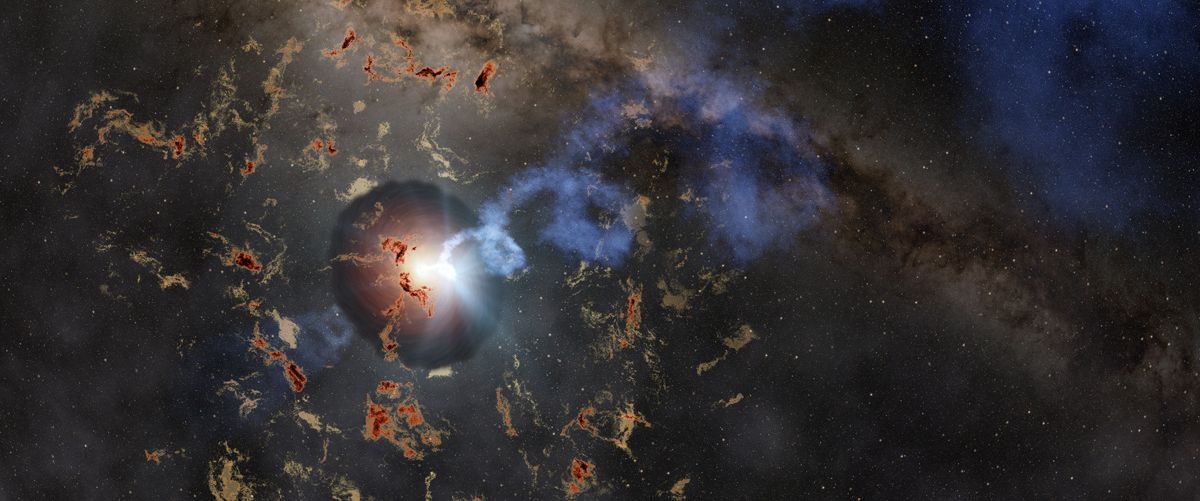ZTF News
Home / ZTF News
The weirdest of them all - a stellar corpse shows signs of life
Nov 15, 2023 | Press Release

Image Credit: Caltech/R. Hurt (IPAC)
[Quoted from the original press release]
After a distant star’s explosive death, an active stellar corpse was the likely source of repeated energetic flares observed over several months – a phenomenon astronomers had never seen before, a Cornell-led team reports in new research published Nov. 15 in Nature.
The bright, brief flashes – as short as a few minutes in duration, and as powerful as the original explosion 100 days later – appeared in the aftermath of a rare type of stellar cataclysm that the researchers had set out to find, known as a luminous fast blue optical transient, or LFBOT.
Since their discovery in 2018, astronomers have speculated about what might drive such extreme explosions, which are far brighter than the violent ends massive stars typically experience, but fade in days instead of weeks. The research team believes the previously unknown flare activity, which was studied by 15 telescopes around the world, confirms the engine must be a stellar corpse: a black hole or neutron star.
“We don’t think anything else can make these kinds of flares,” said Anna Y. Q. Ho, assistant professor of astronomy in the College of Arts and Sciences. “This settles years of debate about what powers this type of explosion, and reveals an unusually direct method of studying the activity of stellar corpses.”
Ho is the first author of “Minutes-duration Optical Flares with Supernova Luminosities,” published with more than 70 co-authors who helped characterize the LFBOT officially labeled AT2022tsd and nicknamed “the Tasmanian devil,” and the ensuing pulses of light seen roughly a billion light years from Earth.
Ho wrote the software that flagged the event in September 2022, while sifting through a half-million cosmic flares, or transients, detected daily by a robotic telescope atop Palomar mountain in California. Led by Caltech and operated by an international collaboration of institutions, the telescope scans the entire northern sky every two nights to produce the Zwicky Transient Facility (ZTF) survey, a treasure trove for astronomers like Ho, who study cosmic transients.
Then in December 2022, while routinely monitoring the fading explosion, Ho and collaborators Daniel Perley of Liverpool John Moores University in England, and Ping Chen of the Weizmann Institute of Science in Israel, met to review new observations conducted and analyzed by Ping – a set of five images, each spanning several minutes. The first showed nothing, as expected, but the second picked up light, followed by an intensely bright spike in the middle frame that quickly vanished.
“No one really knew what to say,” Ho recalled. “We had never seen anything like that before – something so fast, and the brightness as strong as the original explosion months later – in any supernova or FBOT. We’d never seen that, period, in astronomy.”
To further investigate the abrupt rebrightening, the researchers engaged partners who contributed observations from more than a dozen other telescopes, including one equipped with a high-speed camera. The team combed through earlier data and worked to rule out other possible light sources. Their analysis ultimately confirmed at least 14 irregular light pulses over a 120-day period, likely only a fraction of the total number, Ho said.
“Amazingly, instead of fading steadily as one would expect, the source briefly brightened again – and again, and again,” she said. “LFBOTs are already a kind of weird, exotic event, so this was even weirder.”
Exactly what processes were at work – perhaps a black hole funneling jets of stellar material outward at close to the speed of light – continues to be studied. Ho hopes the research advances longstanding goals to map how stars’ properties in life may predict the way they’ll die, and the type of corpse they produce.
In the case of LFBOTs, rapid rotation or a strong magnetic field likely are key components of their launching mechanisms, Ho said. It’s also possible that they aren’t conventional supernovas at all, instead triggered by a star’s merger with a black hole.
“We might be seeing a completely different channel for cosmic cataclysms,” she said.
The unusual explosions promise to provide new insight into stellar lifecycles typically only seen in snapshots of different stages – star, explosion, remnants – and not as part of a single system, Ho said. LFBOTs may present an opportunity to observe a star in the act of transitioning to its afterlife.
“Because the corpse is not just sitting there, it’s active and doing things that we can detect,” Ho said. “We think these flares could be coming from one of these newly formed corpses, which gives us a way to study their properties when they’ve just been formed.”
More Information
"Minutes-duration Optical Flares with Supernova Luminosities" is published in Nature on Nov 15, 2023. Lead author Anna Ho is a partner in the Zwicky Transient Facility which discovered AT2022tsd. Caltech co-authors include
